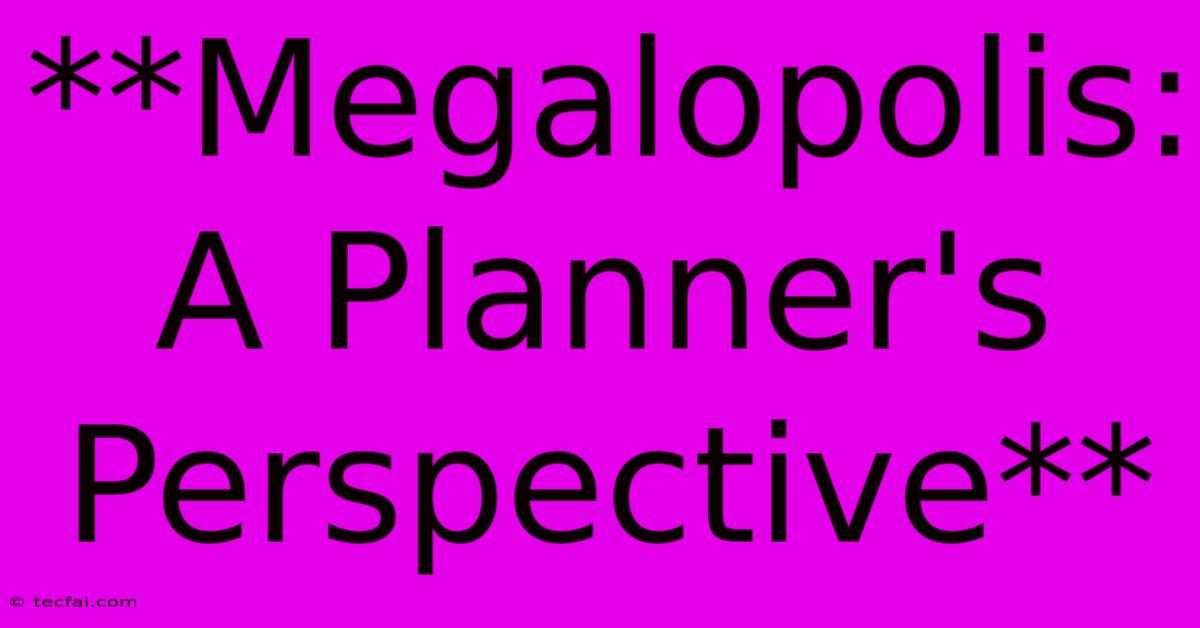**Megalopolis: A Planner's Perspective**

Discover more detailed and exciting information on our website. Click the link below to start your adventure: Visit Best Website tecfai.com. Don't miss out!
Table of Contents
Megalopolis: A Planner's Perspective
The term "megalopolis" conjures images of sprawling urban landscapes, a seemingly endless expanse of concrete, steel, and human activity. But for urban planners, a megalopolis presents not just a visual spectacle, but a complex web of challenges and opportunities demanding innovative and sustainable solutions. This article explores the unique perspective of planners navigating the intricacies of these massive urban agglomerations.
Understanding the Megalopolitan Beast
A megalopolis isn't simply a large city; it's a contiguous network of interconnected cities and suburbs, often blurring the lines between distinct urban areas. Think of the BosWash corridor (Boston to Washington, D.C.), the Tokaido Megalopolis in Japan, or the Rhine-Ruhr region in Germany. These sprawling metropolises boast millions of inhabitants, vast economic power, and significant environmental impact. Planning for such a scale requires a fundamentally different approach than traditional city planning.
The Key Challenges Faced by Planners
Planners tackling megalopolitan challenges face a unique set of hurdles:
-
Infrastructure Development: Meeting the transportation, energy, water, and waste management needs of millions is a monumental task. Efficient and sustainable infrastructure is crucial, requiring significant investment and careful coordination across multiple jurisdictions. This often involves integrating various modes of transportation – high-speed rail, public transit, and cycling infrastructure – to alleviate traffic congestion and promote sustainable commuting.
-
Housing Affordability and Accessibility: The rapid growth of megalopolises often strains housing supply, driving up prices and creating accessibility challenges for lower-income populations. Planners must grapple with creating diverse housing options, promoting affordable housing initiatives, and ensuring equitable access to essential services.
-
Environmental Sustainability: Megalopolises contribute significantly to greenhouse gas emissions and environmental degradation. Sustainable urban planning is paramount, involving strategies to reduce carbon footprint, improve air and water quality, and enhance green spaces. This requires innovative approaches such as green building initiatives, renewable energy sources, and robust waste management systems.
-
Economic Development and Equity: While megalopolises boast significant economic power, ensuring equitable economic growth and reducing income inequality is a critical challenge. Strategic economic development initiatives are crucial, aiming to create jobs, attract investment, and support local businesses, while ensuring benefits are shared across the entire region.
Innovative Solutions and Strategies
Planners are constantly exploring innovative solutions to address these challenges:
-
Regional Planning and Collaboration: Overcoming jurisdictional boundaries is essential. Regional planning agencies play a crucial role in fostering collaboration between different cities and municipalities, coordinating infrastructure development, and implementing shared strategies.
-
Smart City Technologies: Utilizing data analytics, IoT sensors, and other technologies can optimize resource allocation, improve traffic flow, enhance public safety, and improve the overall livability of the megalopolis.
-
Transit-Oriented Development (TOD): Concentrating development around public transportation hubs encourages walking, cycling, and public transit use, reducing car dependency and promoting sustainable urban forms.
-
Green Infrastructure: Incorporating green spaces, parks, and green roofs not only enhances the aesthetic appeal but also improves air quality, manages stormwater runoff, and mitigates the urban heat island effect.
The Future of Megalopolis Planning
The future of megalopolis planning lies in embracing sustainable, resilient, and equitable approaches. This requires a shift from fragmented, city-centric planning towards a more integrated, regional perspective. Collaboration, innovation, and a commitment to long-term sustainability are crucial to ensuring the continued growth and prosperity of these massive urban agglomerations while mitigating their environmental impact and promoting social equity. The challenge is immense, but the opportunity to create thriving, sustainable megalopolises is equally significant. The planner's perspective is vital in shaping the future of these globally significant urban landscapes.

Thank you for visiting our website wich cover about **Megalopolis: A Planner's Perspective**. We hope the information provided has been useful to you. Feel free to contact us if you have any questions or need further assistance. See you next time and dont miss to bookmark.
Featured Posts
-
Margot Robbie Tom Ackerley Enjoy Parenthood
Nov 14, 2024
-
Pandya Shares Wisdom With Cricket Debutant
Nov 14, 2024
-
The Winners Mindset Achieve Success
Nov 14, 2024
-
New Jersey To Sue Trump Over Laws
Nov 14, 2024
-
Momentum Builder Socceroos Next Challenge
Nov 14, 2024
